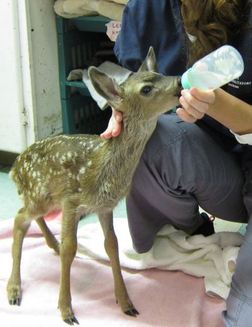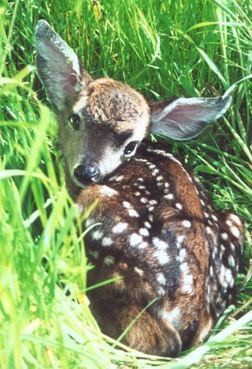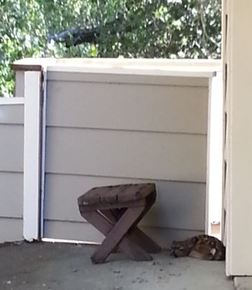WildCare's Wildlife Hospital treats nearly 4,000 ill, injured and orphaned wild animal patients from over 200 species every year. This is one patient's story.
When this Black-tailed Deer fawn arrived at WildCare, his glossy coat and clear eyes at first made medical staff suspect that we had a kidnap victim on our hands.
Not all the fawn patients that arrive at our doors actually need our help. Sometimes a well-meaning person "rescues" a baby animal that is not actually in need of rescue.
In fact, one out of five of the fawn patients brought to the Wildlife Hospital in 2013 was actually healthy and was returned to his mother's care immediately.
With this in mind, medical staff began to examine this spotted baby with the hope that a full belly and excellent hydration would mean Mom had fed him recently and he could be returned to her care.
Unfortunately, the exam quickly revealed that this baby had an empty belly and was dehydrated. Even more tellingly, he had a bad case of diarrhea and fly eggs on his bottom that indicated it had been a while since he had last received a healthy meal of mother's milk and her care. When medical staff offered the baby a bottle of hydrating solution to drink and he took to it immediately, we had another clue that he had been alone for a while. As WildCare's Director of Animal Care, Melanie Piazza says in the video, a healthy fawn would never suck down the tasteless Pedialyte hydrating solution with as much eagerness as did this little patient.
Clearly this baby was not a "kidnap" victim -- he was orphaned and would need to stay at WildCare to be raised with other orphaned fawns in our Foster Care system.
How do you know if a wild animal needs your help?
Every spring WildCare admits a number of baby animals that have been "kidnapped" by well-meaning people who found them alone and assumed they needed help. In fact, one in five of the fawns brought to WildCare in 2013 were healthy and were promptly returned to their mothers.
While every wildlife rescue is done for the most benevolent of reasons, "kidnapping" a healthy baby can have far-reaching impacts on the health of both mom and baby.
The first things to look for if you think a wild animal of any age needs rescue are the Five C's. If an animal demonstrates any of these five symptoms, it is an emergency and he needs immediate help:
1. Is he Crying?
2. Is he Coming toward you (approaching people)?
3. Is he Covered with blood or insects?
4. Has he been Caught by a cat or a dog?
5. Is he Cold?
If the answer to any of these questions is yes, immediately call your local wildlife center for assistance and advice (click for a list of wildlife rehabilitators by state).
In the case of fawns, observing any one of the Five C's indicates that the baby does need help. A fawn's primary defense mechanism is to stay completely still and quiet, nestled into whatever spot his mother placed him while she went off to forage.
Mother deer know that their presence near their babies alerts predators to the fawns' existence, which puts them at risk. In order to keep her young safe, a doe will leave her fawn in a secluded area, often for as long as 12 hours, distracting predators away from her baby while she forages for food.
Fawns' camouflage and their ability to stay still keep them safe from predators while the mother is away. When approached by a perceived predator (humans, pets or wildlife) a fawn's instinctual response is to lay very low and not move at all. People often mistake this defensive behavior for injury, weakness or illness.
But it isn't. A still, quiet fawn is a healthy fawn. You should be worried if you see a fawn acting contrary to this normal behavior.
What does a crying fawn sound like? Click for a recording of the heart-rending call a fawn makes when he's upset. Upon hearing the sound, this fawn's rescuer originally thought he had an exotic bird in his yard.
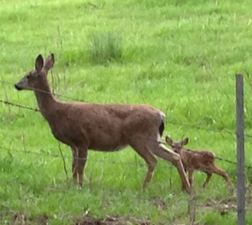
If a mother deer is nearby and hears her baby crying, she will usually come running. But, as you know, a healthy fawn knows his best self-defense is to stay still and quiet.
So a fawn being carried by Wildlife Hospital volunteers back to where he was found figures he'd best stay as quiet as possible until the predators (us!) go away.
When attempting the reunite, the recorder playing the cry is left near the fawn while the people step away to observe from a distance. It is a very effective tool that will often bring the mother deer quickly.
Fortunately, it is a complete myth that a mother wild animal won't accept her baby if he has human scent on him (it's not true about birds either!), so a mother deer attracted by crying calls will immediately take her baby back and lead him to a safer spot.
WildCare receives dozens of calls a week during fawn season from concerned people who find the little animals in their yards. With every caller, our Hotline Operators run through the Five C's. If the answer to any question is yes, they usually ask the caller to bring the fawn to WildCare.
Take the Five C's Quiz!
The Five C's are very obvious symptoms that indicate an animal needs help. But sometimes it's not as clear whether your intervention would be in the animal's best interest.
Take a look at some actual scenarios from WildCare's records and see how you would respond:
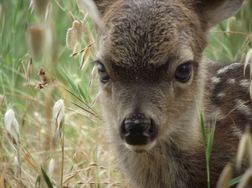
Answer: No! That baby is fine and does not need rescue. Deer, like jackrabbits, will leave their young alone for up to twelve hours at a time while they forage. The babies know to stay still and quiet, tucked into the grass where their mother left them. Sometimes the mother deer makes a poor choice as to where her baby should spend the daylight hours, but she is probably nearby, and worried that a predator (you!) has discovered her fawn. Leave the fawn alone by removing yourself completely from the scene and eventually Mom will come back to retrieve her baby.
Scenario 2: Last night's wind left a lot of debris in the park where you walk your dog. Your foot dislodges a leaf and underneath you find a small fluff-covered bird. He's alive, but his little belly is cool to the touch. Does he need help?
Answer: Yes! That baby definitely needs to come to WildCare. If a baby is cool or cold, he's in trouble and needs help immediately.
Scenario 3: The mockingbird hops around the yard with little trouble, but no matter how long you watch him, he doesn't attempt to fly. There are other birds around, but you're worried about neighborhood cats. Does he need help?
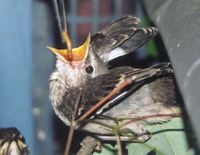
How did you do with these scenarios? For more extensive information to help you determine if a wild animal needs rescue, click to read our Wildlife Rescue Guide!
WildCare is a 501(c)3 nonprofit organization supported almost entirely by private donations and individual memberships. Visit us online at wildcarebayarea.org.

